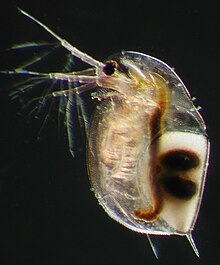Daphnia longispina
| Daphnia longispina | |
|---|---|
| File:Daphnia longispina - female, adut with asexual eggs.jpg | |
| Daphnia longispina - female adult | |
| Scientific classification | |
| Kingdom: | |
| Phylum: | |
| Subphylum: | |
| Class: | |
| Order: | |
| Family: | |
| Genus: | |
| Species: | D. longispina
|
| Binomial name | |
| Daphnia longispina O. F. Müller, 1776 [1]
| |

Daphnia longispina is a planktonic crustacean of the genus Daphnia, a cladoceran freshwater water flea. It is native to Eurasia. D. longispina is similar in size and sometimes confused with the often sympatric D. pulex (a very common species), but much smaller than D. magnaCite error: The <ref> tag has too many names (see the help page).. D. longispina is found in a wide range of standing freshwater bodies from small, ephemeral rock-pools to large lakes Cite error: The <ref> tag has too many names (see the help page).Cite error: The <ref> tag has too many names (see the help page)..
Life history
Like all Daphnia species, D. longispina is a filter feeder, collecting particles of about 2 to 40 µm suspended in the water Cite error: The <ref> tag has too many names (see the help page).. The main food are green algae. At 20°C maturity is reached within about 6 to 12 days, followed by a period of regular reproduction in about 3-4 day intervals. D. longispina reproduces either asexually (parthenogenesis) or seuxally. For the later, females need to produce sons asexually. The same or other females can switch at any moment from asexual to sexual reproduction, but producing haploid eggs, which require fertilization by males. The sexual eggs are then deposited in an ephippium (plural: ephippia, a resting egg shell), which will sink into to the bottom of the water body when the female molts her carapace. After a resting period, which can last several years, the resting stages hatches. Only females emerge from the resting stages Cite error: The <ref> tag has too many names (see the help page).Cite error: The <ref> tag has too many names (see the help page)..
Systematics and evolution
Within the genus Daphnia, D. longispina belongs to the subgenus Hyalodaphnia, sometimes called the D.longispina complex. Closely related species of D.longispina in this complex are D. galeata and D. cucullata, with which D. longispina frequently hybridises Cite error: The <ref> tag has too many names (see the help page).Cite error: The <ref> tag has too many names (see the help page).. A revision of the species complex recently showed that the species D. rosea, D. hyalina and D. zschokkei belong to the species D. longispina, invalidating their species status Cite error: The <ref> tag has too many names (see the help page)..
Parasitism
In contrast to other Daphnia species, (e.g. D. magna) only few parasites have been reported to infect D. longispina Cite error: The <ref> tag has too many names (see the help page). Cite error: The <ref> tag has too many names (see the help page).Cite error: The <ref> tag has too many names (see the help page).. It is however frequently subject to colonization by epibionts, such as peritrich ciliates and algae Cite error: The <ref> tag has too many names (see the help page)..
References
General references
Cite error: The <ref> tag has too many names (see the help page).
Cite error: The <ref> tag has too many names (see the help page).
Cite error: The <ref> tag has too many names (see the help page).
Cite error: The <ref> tag has too many names (see the help page).
External links
- Crustacea.net, an online resource on the biology of crustaceans
- Crustacea: Natural History Museum of Los Angeles County
- Crustacea: Tree of Life Web Project
- The Crustacean Society
- Natural History Collections: Crustacea: University of Edinburgh
Category:Branchiopoda Category:Animals described in 1776 Category:Freshwater crustaceans of Europe
